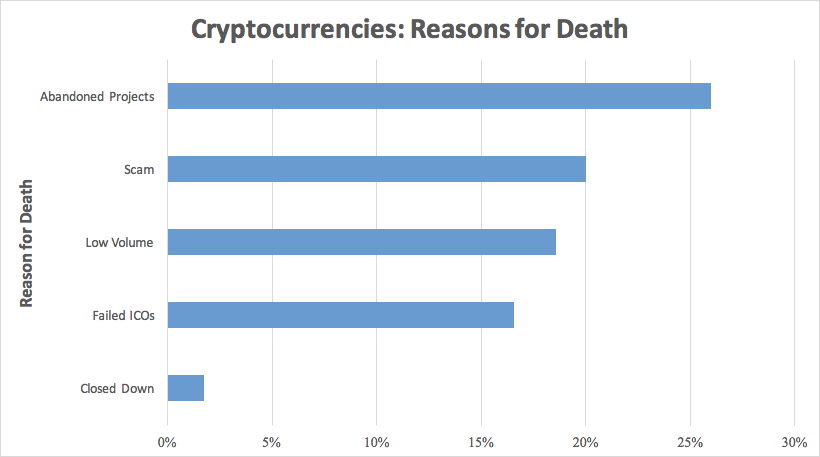Latest news about Bitcoin and all cryptocurrencies. Your daily crypto news habit.

In the last two years, we have seen an explosion in the number of cryptocurrencies. But with so many coins in the market, only a handful have seen any real use. Most projects have not come close to delivering on their grandiose visions.
With so many useless projects floating about, we have to wonder why they’re still around. Why have the bad ones not gone to zero? What’s taking the market so long to punish bad projects?
While we could blame it on a young market, I have a different theory: cryptocurrencies are too robust. It’s too hard for them to die and it’s causing the entire market to suffer.
During the Dot Com bust, bad internet companies eventually ran out of cash and went bankrupt. After the calamity, the market was able to distinguish between the good and the bad. Because of that, the good companies were spared.
This is not happening in crypto. The entire cryptocurrency market is moving together in tandem. Almost every coin in the top 200 by market cap is highly correlated with the rest of the market. Good projects are often obscured by bad ones and bad projects outlive their natural lifespan by feeding off the success of their peers.
To understand why an efficient market requires individuals to be fragile, I’m going to borrow some important ideas from the eclectic Nassim Nicholas Taleb.
The Fragile, the Robust, and the Antifragile
In the book Antifragile, Taleb outlines the difference between three distinct properties.
- Fragility — harmed by volatility
- Robustness — resilient to volatility
- Antifragility — benefits from volatility
We are well equipped to understand both the fragile and the robust because we can easily find examples in our day-to-day lives.

 A porcelain teacup is fragile. A sturdy package wrapped in bubble wrap is robust.
A porcelain teacup is fragile. A sturdy package wrapped in bubble wrap is robust.
But antifragility, the property of growing stronger in a volatile and stressful environment, is not something we often consider.
Our bodies are somewhat antifragile. Exercise, for example, puts stress on our cells. An increase in metabolism generates free radicals which can be very damaging. But the body recovers and grows stronger.
But sometimes stresses are so strong that they are fatal for some individuals. While this is devastating for the individuals themselves,the population comprised of those that survive are fitter on average. This isn’t because any of the survivors grew stronger from the stress, but simply because the weaker individuals were removed.
Taleb calls this mechanism the transfer of antifragility from the individual to the collective. He argues that the fragility of the individual is required to strengthen the collective.
To consider why robust individuals make the collective fragile and why robust tokens would hurt the cryptocurrency market, let’s consider a real-life business example.
A restaurant needs to be fragile for restaurants to be good
As any restauranteur would tell you, the restaurant business is hard. It is an extremely competitive environment where restaurants go bankrupt every minute.
But if you go downtown on a Friday evening, you’re likely to find plenty of good restaurants to eat at.
It is precisely because poor restaurants perish, that the quality of surviving local restaurants is high.
Imagine if restaurants on the brink of bankruptcy were consistently bailed out by taxpayers. We would see a proliferation of poorly run restaurants that offer both terrible food and service. (That’s why banks suck).
These restaurants wouldn’t have any pressure to move off high-rent locations, and would make your Friday evening dining experience miserable.
Removing danger and mortality from failure, causes competition to stagnate or degrade.
Or in the less obvious form, improving the survivability of individuals can actually hurt the well-being of the system.
Applying the lesson of antifragility to cryptocurrencies
We’ve applied lessons of antifragility to nature — why organisms must perish for the species, and the economy — why restaurants need to perish for the industry to be antifragile.
If we apply the same lesson to cryptocurrencies, then it’s obvious to see why individual cryptocurrencies need to be fragile in order for the market to be antifragile.
Many people compare the cryptocurrency bubble to the most recent technology bubble we’ve experienced: the Dot Com bubble.
I think it’s a good point of comparison. But Dot Com companies were not like cryptocurrencies. Dot Com Companies were far more fragile.
Dot Com companies burned out quickly
The prevailing philosophy for most Dot Com companies was “get large or get lost”. As such, companies prioritized growth at all costs even if it meant incurring net operating losses.
Backed by venture capital firms, Dot Com companies expanded headcount aggressively, spent heavily on advertising and promotions, gave away their products for free, threw lavish parties, and rented very expensive offices.
In 2000, there were 16 dot-com commercials during Super Bowl XXXIV, each costing $2 million for a 30-second spot.
The “growth over profits” mentality and the aura of “new economy” led companies to believe they were invincible. While this level of risk-taking was rash, and even suicidal for the individual companies, it was good for the market because it meant that the bad companies could not stick around for long.
Pets.com burned through $300 million dollars and went out of business 9 months after its IPO. Webvan burned through more than $1 billion dollars and went out of business 2 years after its IPO.
By 2004, 52% of Dot Com companies that were founded since 1996 had perished.
Cryptocurrencies Fizzle Out Slowly
According to Coinopsy.com, 350 cryptocurrencies are dead as of August 2018. Compared to the 3,000+ cryptocurrencies that exist, we can roughly say it’s about 10% death rate so far. (DeadCoins reports a higher number, but also has a higher number of obscure coins. The data was also not available for export).
For every coin on its list, Coinopsy also records the reason why they died. Here are the top reasons:
Three of the top five reasons: abandonment, low volume, failed ICOs are all symptoms of projects that are likely to have low traction and inadequate funding.
These are not the reasons Dot Companies failed. Many Dot Com companies failed irrespective of both traction and fundraising. Many well-funded companies went to zero because their burn rate was too high.
The Bigger they are, the harder they fall
GovWorks, eToys, Flooz.com, Garden.com raised a combined $1 billion + dollars, and still went defunct.
Lower Market Cap Cryptocurrencies are More Likely to Fail
Of the 350 cryptocurrencies catalogued on Coinopsy.com, the majority of them had market capitalizations below $25 million.
The fact that we haven’t seen any really big market cap cryptocurrencies fail scares me. (Scams like Bitconnect being an obvious exception.)
Cryptocurrencies are Too Robust
There is virtually zero economic pressure for cryptos to create value.
- Projects that have completed a successful round of financing during the ICO mania have an insanely long run rate. They can survive off the war chest for a really long time.
- Mining offloads the operational expense of keeping the project running to others.
- Unlike companies, there is no pressure for cryptocurrencies to generate revenue and reach profitability. Most projects and investors measure progress by how much code is written, not by how much value the technology captures.
- There is no incentive for the token project to shut down, the founder(s) can simply walk away and keep the project going on its own. e.g. Dogecoin, Litecoin
The blockchain is resilient, redundant, and robust.
- A decentralized blockchain is resilient to death. As long as one miner lives on, the blockchain survives.
- The blockchain network is inherently redundant and has a high degree of fault-tolerance.
- Blockchains are robust against disagreements. The blockchain can be forked. E.g. Bitcoin Cash, Ethereum Classic
Investors have an incentive to attract new capital inflow. Cryptocurrencies take social investing to a whole new level.
- Cryptocurrencies can raise capital very easily because they have access to global markets and retail investors.
- Cryptocurrencies that are traded on a secondary market benefit from the liquidity premium, which allows the founding team to raise capital at a higher valuation.
- Cryptocurrencies lack any semblance of fundamental valuation. Therefore, they invite unbounded levels of speculation.
- Investors have the incentive to drum up hype for others to also buy in. Investor evangelists create a ton of demand for new new entrants. Because they have stake in the project, investor will evangelize the project to a ton of new entrants, especially during a rout.
- Many investors pretend to read whitepapers, but truthfully only a few people actually understand the subtleties. Information overload makes it mentally exhausting to assess the good projects from the bad ones. It’s too difficult to separate noise from signal.
- Institutional investors can keep a company accountable to its goals and put pressure on teams to perform. It’s really hard to organize consensus between thousands of retail investors in order to drive progress.
Most people see the Dot Com bust as a cautionary tale of irrational exuberance, foolish spending, and speculation.
But there are a lot of things that the Dot Com bubble got right, and it took an act of creative destruction to illuminate the companies that were worth building.
It’s been 10 years since the invention of Bitcoin and too many shitcoins have outlived their natural lifespan.
Either we need to hold cryptocurrencies to a higher standard and develop legitimate ways to fundamentally value projects from the bottom-up or we need to figure out ways to make it more costly for bad projects to stick around.
If cryptos are too robust, then the market will suffer.
About the Author
I quit my job recently to start HodlBot.
We automatically diversify and rebalance your cryptocurrency portfolio into the top 20 coins by market cap.Think of it as a long-term crypto-index that you can DIY on your own exchange account.
If you don’t want to index, you can also create a custom portfolio and let HodlBot rebalance it for you.
To get started all you need is a
- Binance Account
- $200 in any cryptocurrency
If you want to know how HodlBot indexes the market and completes rebalancing, check out the blog I wrote here.
Cryptocurrencies Need to Die for the Market to Live was originally published in Hacker Noon on Medium, where people are continuing the conversation by highlighting and responding to this story.
Disclaimer
The views and opinions expressed in this article are solely those of the authors and do not reflect the views of Bitcoin Insider. Every investment and trading move involves risk - this is especially true for cryptocurrencies given their volatility. We strongly advise our readers to conduct their own research when making a decision.


